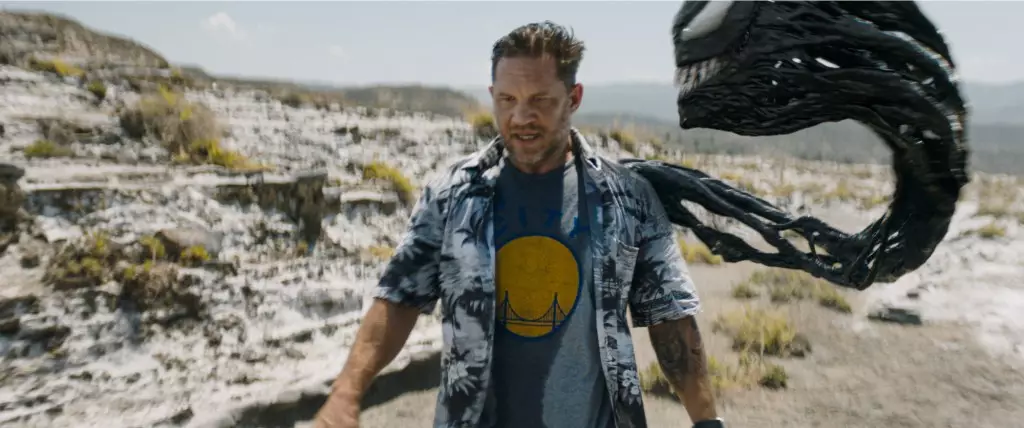In what might be described as an ironic twist, the final chapter of Marvel’s Venom saga, titled “Venom: The Last Dance,” showcases a range of British actors taking on American roles. This intriguing choice adds an unexpected layer to a film that, at its core, revolves around a narrative of conflict and alliance between symbiotic creatures. Leading man Tom Hardy steps into the shoes of Eddie Brock, alongside notable performances from Chiwetel Ejiofor, Juno Temple, and Rhys Ifans. Stephen Graham also makes a brief return from the previous installment, showcasing the persistence of human talent amidst the chaos of superhero warfare. This gathering of British actors forces audiences to reevaluate traditional casting paradigms in superhero films, suggesting that these narratives transcend national identities.
Kelly Marcel, embarking on her directorial debut, approaches “Venom: The Last Dance” with a refreshing yet cautious vision. Unlike many of its predecessors, the film dives right into the story, a choice that emphasizes its intent to address returning fans rather than attempt a lengthy exposition for newcomers. The atmosphere is initially set in a dark prison-like landscape, where the character Knull, portrayed by Andy Serkis, emerges as a looming threat. Marvel’s penchant for bombastic villains resurfaces, as Knull’s declaration of wanting to become the “God of the Void” echoes typical superhero tropes, albeit with a twist.
However, as much as the film attempts to engage audiences right from the start, it soon becomes apparent that the narrative is struggling to find its footing. Unlike the effortless pacing in earlier superhero films, “The Last Dance” sometimes meanders, casting doubt on its necessity in the current cinematic landscape.
The original “Venom” film, which hit theaters two years after “Deadpool,” aimed to harness a mix of dark humor and adult themes while revoking the otherwise PG-13 environment characteristic of the genre. It struck a chord with audiences hungry for edgy storytelling—yet the subsequent installments appear to grapple with how to sustain that balance.
In a sense, the Venom franchise has been given a second chance to carve a niche within the superhero genre, yet the formula remains painfully familiar. The introduction of Eddie Brock’s character as a vessel for the witty, yet dangerous, symbiote provides brief moments of levity, yet the film doesn’t capture the magic that originated the series. While it offers intense action and moments of dark comedy, the film ultimately reflects a recurrent issue – can a superhero franchise genuinely innovate without relying on the worn-out tropes of its predecessors?
The plot of “Venom: The Last Dance” revolves around a race against time as characters battle for control over a codex, a pivotal element that can dictate the fate of the universe. This trope, a marketplace of destruction versus salvation, has been tackled numerous times in the Marvel Cinematic Universe, leading to some predictable story arcs. As the narrative unfolds, new characters, such as Dr. Payne and Gen. Strickland, deepen the layers of conflict involving personal motivations tied to loss and ambition, yet these themes struggle against the film’s inherent predictability.
The character of Eddie Brock is portrayed with hints of complexity, yet he continually falls back on familiar patterns of humor and chaos, which, while entertaining, signify a missed opportunity for deeper storytelling. Rather than pushing boundaries, the film frequently resorts to caricatures of the very people and elements it aims to present with gravitas.
Amidst the highs and lows of character development and plots, the visual execution deserves some commendation. Kelly Marcel claims a level of orchestration that manages to balance chaotic action sequences without succumbing to complete visual disarray, especially when compared to the hyper-stylized onslaught typical of other modern superhero films. Its resemblance to earlier, less frenetic examples of superhero cinema suggests a mature approached, yet it lacks the innovative flair that makes such films compelling.
Ultimately, “Venom: The Last Dance” emerges not as a landmark cinematic experience, but rather as a reminder of the seemingly endless cycle of superhero narratives. It tries to close the book on Eddie Brock, yet congestion manifests as a constant reminder that Marvel films today are often ineffective in finding significant closure or purpose. One might leave the theater entertained, but also grappling with questions about what true originality looks like in a genre that has long relied on formulas rather than fresh narratives. Despite a solid cast and some inspired moments, the venture seems to linger in the shadows of past successes, making one ponder whether the era of the superhero saga is inching toward its twilight.


Leave a Reply